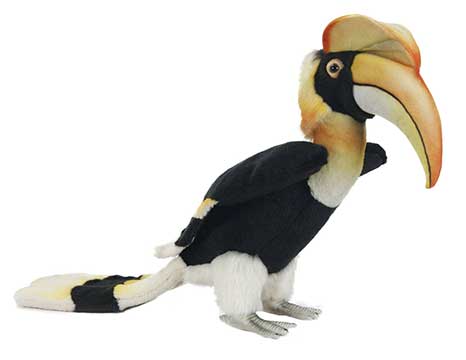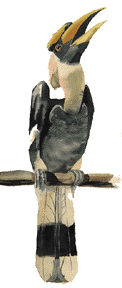


HORNBILLS are medium-sized or large birds that live in Asia and Africa, usually in the jungles. Their most prominent feature is the very large bill, which bears a sizable, brightly colored, horny growth--the casque. Though the bird has the appearance of being out of balance, the casque is generally very light; it is made up of thin-walled hollow cells. The flight of the hornbill is heavy and sluggish.
The hornbill is famous for its very unusual nesting habits. Once courtship and mating are at an end, the female retires to a hollow tree and seals herself into the chamber with a clay-like substance made up of dung and pellets of mud. The male gathers these materials on the forest floor and swallows them. Later he expels them in the form of small saliva-made pellets which
he gives to the female who stays inside the nest. She plasters them on the sides of the entrance. At last a slitlike window remains which is just big enough to receive part of the bill. For the next six or eight weeks the male feeds the female through this opening. The imprisoned female lays a few white eggs. While incubating, she begins a complete molt and for a time is flightless, having lost all her wing and tail feathers.
Among many hornbills the female breaks her way out of the nest a week or more before the young are ready to leave the shelter. Dressed in all-new feathers, she helps her mate feed their young. Due to the amazing coding within the bird's dna, the babies immediately rebuild the entrance barrier.
Most hornbills are black and white, sometimes varied with chestnut or gray. Their legs and feet are short and rather weak. Most hornbills are fruit eaters. There are some 46 species that make up the family. The red-billed hornbill is shown at left above.
Find the Hansa Malaysian Hornbill plush bird at our sponsor's online gift shop : www.jeanniescottage.com.




